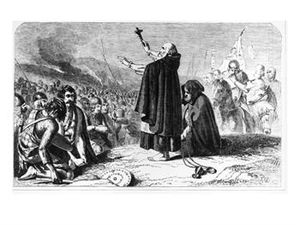- Maurice of Inchaffray
-
Maurice (Scottish Gaelic: Muireach or Muireadhach) was a 14th century Scottish cleric who became Prior of Inchmahome, Abbot of Inchaffray and then Bishop of Dunblane. He was Prior of Inchmahome Priory in Menteith after 1297.[1] He became abbot of Inchaffray Abbey in Strathearn between March 1304 and October 1305.[2] As Abbot of Inchaffray, he held a canonry in the diocese of Dunblane, that is, the precentorship of Dunblane Cathedral (also in Strathearn).[3] After the death of Nicholas de Balmyle, he was elected to the bishopric of Dunblane. He was consecrated to the see before March 23, 1322, after litigation at the Papal court. King Edward II of England had nominated one Richard de Pontefract to the see, while Roger de Ballinbreich had also been elected by the chapter; both of these men were overlooked by the Pope in Maurice's favour.[4]
Maurice has achieved some popular fame because of his role as an early supporter of King Robert I of Scotland and as chaplain at the Battle of Bannockburn. Maurice was probably one of the people who helped Robert after his defeat at the Battle of Methven in 1305.[5] Robert I's first recorded act as king involved Abbot Maurice, who was given a "credence" (like empowering a Plenipotentiary or possessor of Power of Attorney) to speak with Maol Íosa III, Earl of Strathearn on his behalf.[6] Maurice was in England with a grant of safe-conduct in January 1313, probably on a mission to attempt to make peace between the two kings.[7] At the Battle of Bannockburn in 1314, Maurice was the chaplain of the Scottish army and gave an encouraging speech and blessing to the Scottish soldiers. According to a legendary account found in the writings of Hector Boece, Maurice brought to the battlefield the silver reliquary known to contain the left arm-bone of St Fillan, but for safety left the actual arm of the saint in the monastery. The arm-bone, however, miraculously made its own way to the battlefield where it helped bring the Scots victory.[8]
His later career is largely unrecorded. He died in the 1340s, definitely before October 23, 1347, when William de Cambuslang, his successor as Bishop of Dunblane, was consecrated.
Notes
- ^ Ian B. Cowan, & David E. Easson, , Medieval Religious Houses: Scotland With an Appendix on the Houses in the Isle of Man, (London, 1976), 108.
- ^ Ibid, p. 102.
- ^ James Hutchison Cockburn, The Medieval Bishops of Dunblane and Their Church, (Edinburgh, 1959), pp. 54, 90.
- ^ D. E. R. Watt, Fasti Ecclesiae Scotinanae Medii Aevi ad annum 1638, 2nd Draft, (St Andrews, 1969), p. 76.
- ^ G. W. S., Barrow, Robert Bruce and the Community of the Realm of Scotland, (Edinburgh, 1988), p. 60.
- ^ Chris Brown, Robert the Bruce: A Life Chronicled, (Stroud, 2004), p. 9.
- ^ Barrow, Robert Bruce, p. 200.
- ^ Cockburn, Medieval Bishops of Dunblane, 93.
References
- Barrow, G. W. S., Robert Bruce and the Community of the Realm of Scotland, (Edinburgh, 1988)
- Brown, Chris, Robert the Bruce: A Life Chronicled, (Stroud, 2004)
- Cockburn, James Hutchison, The Medieval Bishops of Dunblane and Their Church, (Edinburgh, 1959)
- Cowan, Ian B. & Easson, David E., Medieval Religious Houses: Scotland With an Appendix on the Houses in the Isle of Man, (London, 1976)
- Watt, D. E. R., Fasti Ecclesiae Scotinanae Medii Aevi ad annum 1638, 2nd Draft, (St Andrews, 1969)
Religious titles Preceded by
AdamPrior of Inchmahome
1297 x 1309Succeeded by
CrístinPreceded by
ThomasAbbot of Inchaffray
1303 x 1305–1322Succeeded by
CrístinPreceded by
Nicholas de BalmyleBishop of Dunblane
1319 x 1322–x 1347Succeeded by
William de CambuslangPre-Reformation Bishops of Dunblane
"M. de Dunblan" · Laurence of Dunblane · Simon of Dunblane · Jonathan of Dunblane · Abraham of Strathearn · Radulf (bishop-elect) · Osbert of Dunblane · Clement of Dunblane · Robert de Prebenda · William · Alpín of Strathearn · Nicholas of Arbroath · Nicholas de Balmyle · Richard de Pontefract · Roger de Balnebrich · Maurice of Inchaffray · William de Cambuslang · Walter de Coventre · Andrew Magnus · Dúghall of Lorne · Fionnlagh MacCailein · William Stephani · Michael Ochiltree · Walter Stewart · Robert Lauder · John Herspolz · John Spalding · James Chisholm · William Chisholm (uncle)
Italics indicate non-consecrated or titular bishops.Post-Reformation Bishops of Dunblane
William Chisholm (uncle) · William Chisholm (nephew) · Andrew Graham · George Graham · Adam Bellenden · James Wedderburn · Robert Leighton · James Ramsay · Robert DouglasCategories:- 1340s deaths
- Bishops of Dunblane
- Medieval Gaels
- Scottish abbots
- Scottish priors
- 14th-century Roman Catholic bishops
- People of the Wars of Scottish Independence
Wikimedia Foundation. 2010.

